Yu. A. Tukhtaboeva1, Sh. J. Tojiboyev2
1PhD, Namangan State University, Uzbekistan
2Candidate of Biological Science, Namangan State University, Uzbekistan
Correspondence to: Yu. A. Tukhtaboeva, PhD, Namangan State University, Uzbekistan.
| Email: |  |
Copyright © 2023 The Author(s). Published by Scientific & Academic Publishing.
This work is licensed under the Creative Commons Attribution International License (CC BY).
http://creativecommons.org/licenses/by/4.0/

Abstract
South-facing slopes (SFS) may receive six times higher solar radiation than north-facing slopes (NFS). Although located only a few hundred meters apart, the microclimatic conditions on the slopes vary dramatically, affecting the biology of organisms at all levels (M.Auslander et.al. 2003). Non-uniform conditions for the development of plants are created on slopes with different exposures. For example, due to the non-uniform temperature regime on the northern and southern slopes, heating is less on the northern slopes. in spring, snow melts faster on southern slopes, which directly accelerates erosion. Insufficient moisture on the southern slopes of the soil causes discomfort for the development of tall plants, which ultimately leads to summer erosion of the soil. The processes occurring on the eastern slopes occupy an intermediate position. In addition, since the complex of geomorphological and soil processes on the slopes is not at the same level, microzones are formed on the slopes and their agrochemical indicators are different. In this research work, the dynamics of algae development on the slopes are presented.
Keywords:
Algae, Exposition, Green algae, Bacillariophyta, Cyanobacteria, Microzone, Erosion
Cite this paper: Yu. A. Tukhtaboeva, Sh. J. Tojiboyev, The Dynamics of the Influence of Slope Exposition on the Algae in Eroded Soils, International Journal of Virology and Molecular Biology, Vol. 12 No. 1, 2023, pp. 1-6. doi: 10.5923/j.ijvmb.20231201.01.
1. Introduction
The rate of water erosion occurring on the slopes of different exposures also affects the condition of algoflora in the soil. There are also a number of scientific studies focused on the algae of the slopes (E.A. Shtina, 1959; Gollerbax, 1964; K.Y. Musaev, 1967; Sh.J. Tojiboev, 1973; E.I. Troiskaya, 1961; Patova, 1998). In these studies, there is almost no information on the vegetation cover, including the taxonomy of algae, on factors such as the length of the slope, the slope. Many authors did not pay attention to erosion processes on slopes in their research. There are few such works and they were also created by E.I. Dubovik (Dubovik, 1998) works. Based on the data of E. Dubovik, he focused on the algal flora of eroded soils and algal evaluation of soil protection measures. In order to determine the effect of exposure of the slope on the condition of algoflora, we believe that it is appropriate to carry out the research in one climatic region on a soil suitable for one type. It is better that algofloras have the same appearance, slope, and continuity of the investigated slopes as much as possible. In this regard, it is good that the edificators of the phytocenoses in it are not greatly differentiated. Algoflora of four exposures of slope edificators were studied on the hill slopes of the first field of dry land in the uneven terrain with karet limestone with positive and negative differences. The researches were conducted in the eroded soils of the Fergana Valley and in the eroded slopes of Andijan, Namangan, and Fergana regions.
2. Materials and Methods
Taking soil-algological samples. Soil sampling Soil-algological samples were taken using the methods of Gollerbach and Shtina (1969). The sampling site was taken from the eroded soils of the slopes of the Fergana Valley. To determine the location of the GPS species from the database of the Global Biodiversity Information Service (www.//gbif.org/), samples of Algology collections of the Institute of Botany of the RFA were used and the database data included in them. The geographic coordinates were obtained using the Google Earth Pro 7.1 (https://www.google.com/earth/) program and filled with data collected as a result of field research in the Ferghana Valley (Central Asia) and the slope Algae distribution maps are shown in the figures. The WGS 84 international geological coordinate system (World Geodetic System 1984) was used to create the maps. The obtained soil-algological samples were taken from three layers of slope soils. That is, A, B, C are horizons. From a depth of 0-5 cm to 50 cm. The obtained samples were placed in special bags and immediately air-dried in laboratory conditions. We also used the methods of several scientific researchers in our research work (Esmarch, 1911; Lund, 1920; Fritsch and John, 1942; Pringsheim, 1944; Gornyunova, 1948; Gollerbach and Polyansky, 1951; Guseva, 1956; Starr, 1960; Vladimirova and Semenenko, 1962) methods were used. Isolation and cultivation. In the second method, the green mass was planted on a liquid nutrient medium Bristol (1920), the green mass formed on the wall of the test tube was subsequently subcultured many times on a solid nutrient medium BG 11 with nitrogen (1% agar, pH = 7.0) (Media for blue-green and green algae, modified by Allen, 1968; Stainer, 1968; Rippka et al., 1979) and take a clean sample of algae. All obtained isolates were cultivated in a climostat under standard conditions (temperature + 22-24, illumination 65-75 m mol backgrounds, photoperiod 102). Microscopy. The study of strain morphology was carried out using light microscopy methods. Model N-300 (UCMOS09000KPB) and Model Kern optics ODC 241. The results of observations were documented by photographs taken with digital cameras (9.0 MP 1/2.4). The time of observation of the strain ranged from 10 hours to 2 months.
3. Results and Discussion
The exposure of the hill slope in the first field can be seen to study the effect of the development of algae in the field. The observation shows that the distance from the top of the hill to the bottom of the hill was washed away on the northern slope, and it was noted that it was strong on the southern slope. The mainly eroded soils of the Fergana valley correspond to Yaypan regions of the Fergana region, and slope erosion occurs. In these areas, the two sides of the slope cause unique big differences in the development of algoflora, and the composition of species identified here is Fig. 1 and presented in tables.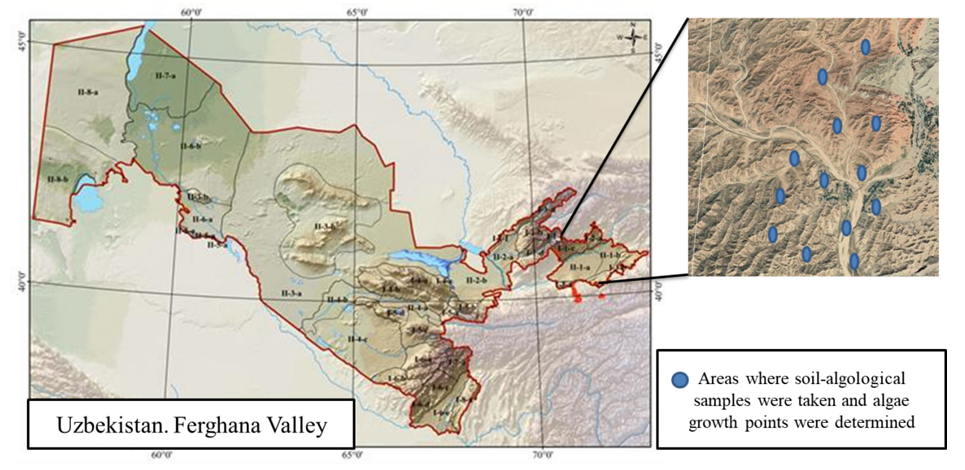 | Figure 1. The maps Uzbekistan |
The number and biomass of algae cells was maximum on the northern slope and minimum on the southern one. The indicators of the data obtained from the eastern and western slopes took an intermediate place. Algae from the mound soils were not detected when we directly looked at the soils under a microscope to compare the algoflora of the almost completely washed over hill and the unwashed soils. The samples were taken in special packages, grown in laboratory conditions and microscopic analysis was carried out.Among the four exposures of the soils, where the surface of the soil was not washed away under the influence of the water climate, among the algoflora on the northern slope, on the slope with moderate humidity, the diversity was stronger and the polydominance was well demonstrated (Table 1). Algae of different systematic groups formed dominance.H-forms of hygrophilous stringy green and yellow-green algae were found in algoflora. Chlorhormidium flaccidum, Stichococcus minutissimus, Leptosira terricola, Heterothrix exilis, Bumilleria sicula belonging to Xantophyta Tribonematales, belonging to Ulotrichales, were noted in large numbers. Stichococcus minor, Stichococcus minutissimus, Heterococcus chodatii, Chlamydomonas globosa are specific species for the studied slope. On other slopes, the algoflora of algae was simplified. In this regard, the southern slope is not rich in species of algoflora. Analyzes of ecological groups of algae were also carried out. Main Ch-form: Chlorococcum hypnosporum, Chlorella vulgaris, Chlorosarcinopsis minor, Botrydiopsis eriensis returned. Compared with the algoflora found on the northern slope, the moisture-loving X- and H- forms were not found. At the same time, drought-resistant P-form species, of which; Phormidium foveolarum, Ph. Angustissimum, Ph. molle was noted. The 4 identified species were identified in Chlomidomonas [C-form], palmelloid state. These are the specific species of the slope, namely Chlamydomonas terrestris, Ch. oblongella, Plectonema boryanum.The algoflora identified from the western and eastern slopes took an intermediate position with algae from the northern and southern slopes. Unicellular green and yellow-green algae were found on these slopes. For the eastern slope, Botrydiopsis eriensis, and for the western slope, Characium bulbosum were considered specific species. The obtained data are shown in Figures 2 and 3. | Figure 2. North (A) and south (B) slopes distribution of algae in expositions. 1-total number of cells; 2-cyanobacteria; 3-green and yellow-green algae; 4- diatom algae; The dotted line represents soil moisture |
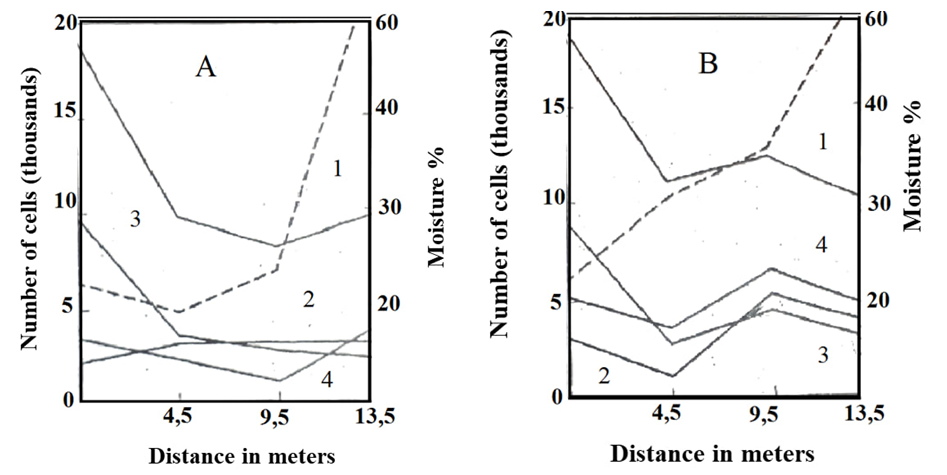 | Figure 3. Western (A) and southern (B) slopes distribution of algae in expositions. 1-total number of cells; 2-cyanobacteria; 3-green and yellow green algae; 4- diatom algae; The dotted line represents soil moisture |
When analyzing the number of species, the largest number of algae species was found in the flat part. Algoflora of the exposure of the northern slope took second place with 34 species. There are no significant differences in the number of algoflora species of the exposition of the south-western and eastern slopes. There is a favorable hydrothermal condition for the development of algae groups in this place, which is characteristic of the exposure of the northern slope, where there is a lot of biodiversity (E.I. Dubovik, 1998).Information about the taxonomic structure of the algoflora and the spectrum of ecobioforms of the slope exposure is presented in Table 1 below.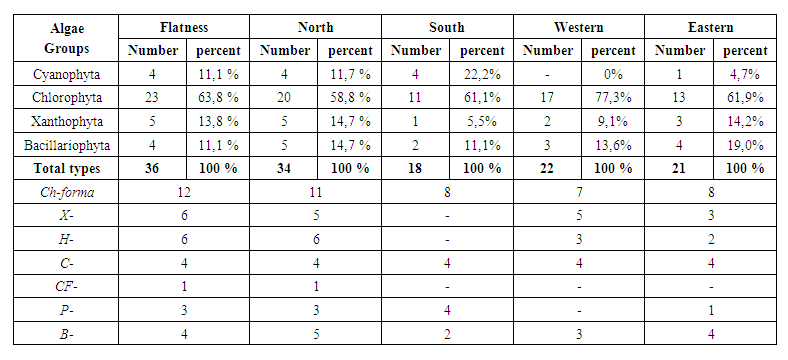 | Table 1. The effect of slope exposure on the taxonomic composition of algoflora and the spectrum of ecobioforms |
Table 2. Algae species distribution depending on exposure
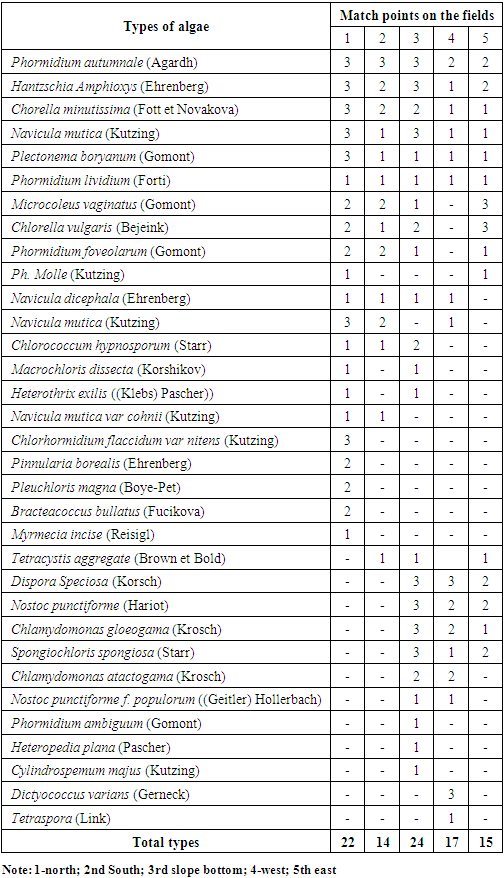 |
| |
|
Phormidium autumnale, Ph. lividum, Plectonema boryanum, Chlorella minutissima, Hantzchia amphioxys and Navicula mutica var cohni were found in all areas. Microcoleus vaginatus, Chlorella vulgaris, Phormidium foveolarum, Navicula pelliculosa were recorded in 4 areas. It turned out that 7 types are distributed in 3 areas. The remaining species were found in the soils of the 1st and 2nd fields.Cyanophyta Phormidium autumnale was the first, Hantzschia amphioxys was the second, Chlorella vulgaris and Navicula mutica were in the third place in terms of the number of habitats in the samples. The next places were occupied by Microcoleus vaginatus and Dispora speciosa.Comparing the algoflora of the studied sites in pairs, the similarity of the lower relief of the hill with other elements was high (K>50%), which, in our opinion, was caused by the water of the swamps coming from above. We have seen that the biodiversity of algae in this place is the highest because the humidity of this place is higher than other places. The presence of plant cover in this place (about 90%) was explained by the competitive situation of algae (E.A. Shtina, M.M. Gollerbach, 1976).The influence of slope exposure on the seasonal dynamics of algae, species composition, number and biomass of cells, was studied on dry land without water erosion and on eroded land. The obtained results showed that there are favorable conditions for the moderate development of algae on the eastern slopes (Table 3).Algae development dynamics are different in soils of eroded and unwashed slopes. In the first and fourth plots where erosion did not occur, the number of algae cells and their biomass was maximum in April and August. It was found that the difference in algoflora in the areas where erosion did not occur is related to the differences in tall plants and soil cover.Due to the fact that the cover of these plants is thicker in the first plot, the development of algae was not allowed in this place compared to the fourth plot. One maximum was determined in the cells and biomass of the slopes where erosion occurred. In the soils of the eastern slopes, all indicators of algoflora became maximally important.The data presented that the number and biomass of algae in the eroded areas increased after the rain. Cyanobacteria were rarely found in the summer months, diatoms, green and yellow-green algae were recorded on the slopes after rain.The number of species and dynamics of algae in algoflora correspond to quantitative indicators. The effect of slope exposure on the dynamics of the number of algae species is presented in Table 3.Table 3. The influence of slope exposure on the number dynamics of algae species
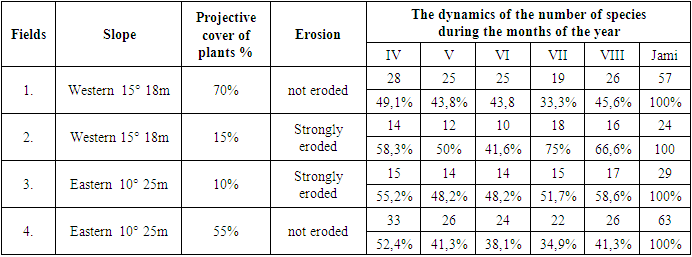 |
| |
|
It turned out that the number of algae species detected in the first and fourth sections of the slope exposure is more than doubled. The number of algae determined from the plots with a strong degree of erosion showed a similar indicator. In the third area, the lack of projective cover of plants and the lack of competition showed an effect on the number of species in the algoflora in the soil. It turned out that the types of algae found on the eastern slope are 5 more than those on the western slope.
4. Conclusions
Thus, exposure of the slopes was proved on the basis of the obtained data on the number, biomass and taxonomic composition of algal flora cells. Due to the fact that the exposure of the slope cannot retain the water factor, this situation has a negative effect on the development of soil algoflora. The effect of this factor was more pronounced in eroded soils, therefore, we believe that it is necessary to take this situation into consideration in the rules of further algological research.
ACKNOWLEDGMENTS
For their practical assistance to the scientific staff of the Geobotany Laboratory of the Botany Institute of the Republic of Uzbekistan Academy of Sciences in the process of species identification in the use of the Model Kern optics ODC 241 microscope and for their special practical assistance in the cultivation of soil algae strains at the Institute of Microbiology of the Republic of Uzbekistan Academy of Sciences we express our gratitude to the scientific staff.
References
| [1] | A. D. Temraleeva, E. V. Mincheva, Yu. S. Bukin, A. M. Andreeva. Modern methods of isolation, cultivation and identification of green algae (Chlorophyta). – Kostroma: Kostroma house, 2014. -215 p. |
| [2] | Andreeva V.M. Soil and aerophilic green algae (Chlorophyta: Tetrasporales, Chlorococcales, Chlorosarcinales). - St. Petersburg: Nauka, 1998. - 351 p. |
| [3] | E.A. Shtina, M.M. Gollerbach. Ecology of soil algae. - M: Nauka, 1976. 142 p. |
| [4] | O.V. Anisimova, M.A. Gololobova. A brief guide to the genera of algae in the Moscow region. – M. Moscow, 2006. 155 p. |
| [5] | N.A. Moshkova, M.M. Gollerbach. Key to freshwater algae of the USSR. Issue 10. Green algae. L: Nauka, 1986. 360 p. |
| [6] | S.A. Khalilov, R.Sh. Shoyakubov, A.Temirov, N.K. Kozirakhimova, Sh.Zh. Tazhibaev. Ulothrix algae of Uzbekistan. - Namangan, 2012. 263 p. |
| [7] | Anh Tu Van, Veronika Sommer, Karin Glaser. The Ecophysiological Performance and Traits of Genera within the Stichococcus -like Clade (Trebouxiophyceae) under Matric and Osmotic Stress. Microorganisms 2021, 9 (9), 1816. |
| [8] | Brown, LM; Hellebust, JA. Sorbitol and Proline as Intracellular Osmotic Solutes in the Green Alga Stichococcus bacillaris. January 2011 Canadian Journal of Botany 56(6): 676-679 DOI: 10.1139/b78-074. |
| [9] | Dubovik I.E. Stress of soil algae under the influence of erosion// Bulg. J. Plant Physiol. - 1998- Special issuue. - P. 277. |
| [10] | Ladislav Hodac, Christine Hallmann, Karolin Spitzer, Josef Elster, Fabian Faßhauer, Nicole Brinkmann, Daniela Lepka, Vaibhav Diwan, Thomas Friedl. Widespread green algae Chlorella and Stichococcus exhibit polar-temperate and tropical-temperate biogeography. FEMS Microbiology. Ecology. 92, 2016.fiw 122. PMID: 27279416 DOI: 10.1093/femsec/fiw122. |
| [11] | Lewin, RA A Marine Stichococcus sp. Which Requires Vitamin BI2 (Cobalamin). J. Gen. microbiol. 1954, 4, 93–96. |
| [12] | M.Auslander, Eviatar Nevo, Moshe Inbar. The effects of slope orientation on plant growth, developmental instability and susceptibility to herbivores. November 2003. Journal of Arid Environments 55(3): 405-416 DOI: 10.1016/S0140-1963(02)00281-1. |
| [13] | Sommer, V.; Mikhailyuk, T.; Glaser. K.; Karsten. U. Uncovering Unique Green Algae and Cyanobacteria Isolated from Biocrusts in Highly Saline Potash Tailing Pile Habitats, Using an Integrative Approach. Microorganisms 2020, 8(11), 1667; https://doi.org/10.3390/microorganisms8111667. |
| [14] | Thomas Proschold & Tatyana Darienko. The green puzzle Stichococcus (Trebouxiophyceae, Chlorophyta): New generic and species concept among this widely distributed genus. // May 2020 Phytotaxa 441(2): 113-142 DOI: 10.11646/phytotaxa.441.2.2. |





 Abstract
Abstract Reference
Reference Full-Text PDF
Full-Text PDF Full-text HTML
Full-text HTML


